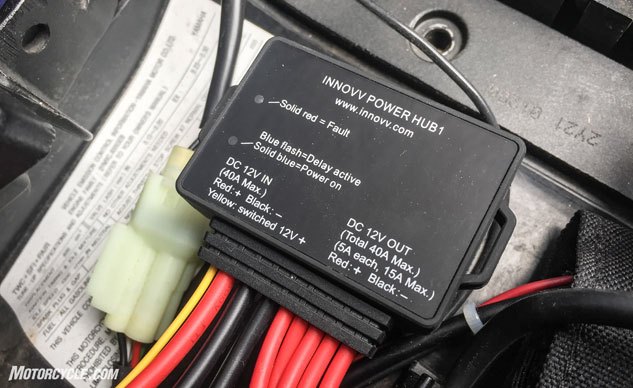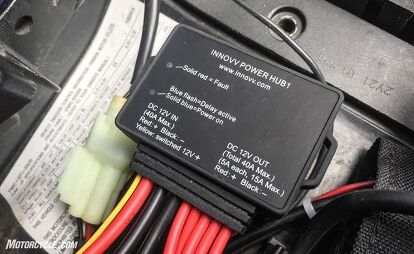MO Tested: Innovv Power Hub1

Power all your motorcycle accessories in one place
Okay, I admit it. I’m a gadget guy, and quite frequently, those around me have to suffer through endless conversations about the latest shiny technology that has caught my eye. (Just ask my long-suffering wife, whose patience in my current home automation project is wearing quite thin.) So, you shouldn’t be surprised that, at every weekly production meeting for the past couple months, I’ve tried to schedule a review of the new Power Hub1 from Innovv. Why is it so special? Well, it allows for switched power to be distributed to up to five accessories from one location – which translates into just one switched connection to be spliced into a bike’s wiring harness.
MO Wrenching: How To Properly Splice Wires
Turn On: How To Install Switched Accessory Power To Your Motorcycle
Portable Power: How To Install Powerlet Electrical Sockets
Since I’ve covered the installation of switched accessory power, Powerlet electrical sockets, and proper wire splicing in previous articles, I’m going to focus on what the Innovv Power Hub1 brings to the party. The Power Hub1 allows for the installation of switched power delivery for five accessory circuits of up to 15 amps each (as long as the total doesn’t exceed 40 amps). Additionally, the Hub1 delays the power to the accessories for 10 seconds after the ignition is switched on to allow the starter motor to have access to the full cranking power of the battery – a real boon in low-battery situations.
The other benefits are a little less obvious on first glance. If you’re only installing one accessory on your motorcycle, splicing into the wiring harness is not a big deal, but if each new accessory requires a new cut to draw power, you increase your chances of electrical problems because of the multiple potential points of failure. With the Power Hub1, only one splice needs to be made. The trade-off is that you will need to run wires from the hub to the location of the accessories.
The Power Hub1 is a 64.2mm x 39mm x 40mm, (2.5” x 1.5” x 1.6”) plastic block that you mount on your bike. The interface consists of two LEDs that signal the hub’s status: solid red for wiring fault, flashing blue for delay mode, and solid blue for active. The hub’s wires are separated into two groups, with the first powering the hub and the second distributing it to the accessories.
A pair of 12-gauge wires that get connected to the battery power the hub. The positive lead has a 40-amp fuse already installed. The 22-gauge yellow wire attaches to a switched power source and is used as a trigger for the Power Hub1. The remaining six wires consist of five 16-gauge fused wires and a single 12-gauge negative. While you can simply ground the accessories to the frame, using the common negative wire again reduces the number of locations of points of potential circuit failure.
The single complaint I have about the Power Hub1’s construction is the length of the five positive pigtails. While 12-inches is a good length, it takes up a ton of room on a bike – particularly with the fuse holders. I’d prefer to have some sort of connector arrangement to keep the unused pigtails shorter. However, a motivated end-user could fit those individually.
Installation of the Power Hub1 is as easy as making the wire connections and finding a place to mount the hub on the motorcycle. Touring bike owners will find this task easier than sportbike riders. If any single accessory circuit will draw more than 5 amps, you’ll need to add a higher rated fuse (up to 15 amps) to the pigtail. Again, you should be cognizant of the total amperage draw to avoid exceeding the 40-amp limit.
MO Tested: Innovv K1 Motorcycle Camera Review
The Innovv Power Hub1 works exactly like I hoped it would – unobtrusively. It switches on the power to my Innovv K1 dash cam and the accessory socket on my fairing after the aforementioned 10-second delay and switches the accessories off with the ignition. I highly recommend the Power Hub1 for riders who want to install multiple switched accessories to their motorcycles. You can buy the Power Hub1 directly from Innovv’s website for $69. www.Innovv.com

Like most of the best happenings in his life, Evans stumbled into his motojournalism career. While on his way to a planned life in academia, he applied for a job at a motorcycle magazine, thinking he’d get the opportunity to write some freelance articles. Instead, he was offered a full-time job in which he discovered he could actually get paid to ride other people’s motorcycles – and he’s never looked back. Over the 25 years he’s been in the motorcycle industry, Evans has written two books, 101 Sportbike Performance Projects and How to Modify Your Metric Cruiser, and has ridden just about every production motorcycle manufactured. Evans has a deep love of motorcycles and believes they are a force for good in the world.
More by Evans Brasfield




































Comments
Join the conversation
I personally use the FZ-1 by Fusebox. Each circuit is fused in the box itself and you connect directly to the bus. No splices. A common bus ground. Indicator lights for each circuit. And, if I remember right, the connections can be either switched or not
I am currently using the relatively pricier (and feature rich) Rowe PDM60. The Power Hub 1 seems to be competitively priced for what it offers though. I didn't realize the FZ1 was capped @ 10A per circuit. Nonetheless, it still seems like a good alternative. A couple other options are the Denali Powerhub2 and Eastern Beaver PC8. Not as budget friendly but perhaps might appeal to some folks.